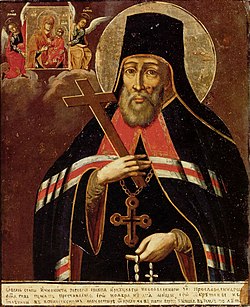Top Qs
Timeline
Chat
Perspective
February 9 (Eastern Orthodox liturgics)
From Wikipedia, the free encyclopedia
Remove ads
February 8 - Eastern Orthodox liturgical calendar - February 10

All fixed commemorations below are observed on February 22 by Eastern Orthodox Churches on the Old Calendar.[note 1]
For February 9, Orthodox Churches on the Old Calendar commemorate the Saints listed on January 27.
Feasts
- Leavetaking of the Presentation of our Lord.[1][2][note 2]
Saints
- Hieromartyrs Marcellus, Bishop of Sicily,[1] Philagrius, Bishop of Cyprus,[1][3] and Pancratius, Bishop of Taormina,[1] disciples of Apostle Peter (1st century)[4][5][6][note 3]
- Martyrs Ammonius and Alexander of Cyprus, at Solia in Cyprus (c. 248-251)[1][7][note 4]
- Saint Apollonia of Alexandria, martyr (249)[4][9][10][11][note 5]
- Martyr Nicephorus of Antioch in Syria (c. 257)[1][4][9][12][13][14][note 6]
- Venerable Romanus the Wonderworker, of Cilicia, near Antioch (5th century)[1][4][9][15] (see also: November 27)
- Venerable Shio Mgvime of Georgia (6th century)[16][17] (see also: May 9)
- Hieromartyr Peter, Bishop of Damascus, by the sword (743 or 775)[1][4][9][18][note 7][note 8]
Remove ads
Pre-Schism Western saints
- Martyr Alexander of Rome and thirty-eight other martyrs with him.[22][note 9]
- Martyrs Ammon, Emilian, Lassa and Companions, a group of forty-four Christians martyred in Membressa in Africa.[22]
- Martyrs Primus and Donatus, two Deacons in Lavallum in North Africa martyred by Donatists (362)[22][note 10]
- Saint Nebridius, Bishop of Egara near Barcelona in Spain, a city since destroyed (c. 527)[22]
- Saint Sabinus of Canosa, Bishop of Canosa in Apulia in Italy and Confessor, and a friend of St Benedict (c. 566)[8][22][23][note 11]
- Saints Aemilianus and Bracchio, of Tours in Gaul (6th century)[4][9]
- Saint Teilo (Theliau, Teilan, Dillo, Dillon), Bishop of Llandaff, Wales (6th century)[4][9][22][24][25][note 12]
- Saint Einion Frenin (Eingan, Eneon, Anianus), a British prince who left Cumberland for Wales and became a hermit at Llanengan near Bangor (6th century)[22]
- Saint Ansbert of Rouen, third abbot of Fontenelle Abbey and then Bishop of Rouen (c. 700)[22][26][note 13]
- Saint Cuaran (Curvinus, Cronan), a bishop in Ireland, called 'the Wise' - on account of his knowledge of the canons - who hid his identity to become a monk at Iona, where he was recognised by St Columba (c. 700)[22][27]
- Saint Alto of Altomünster, founder of Altomünster Abbey (c. 760)[22][28][note 14]
Post-Schism Orthodox saints
- Venerable Pancratius, hieromonk of the Kiev Caves Monastery (13th century)[4][9][29]
- Saints Gennadius (c. 1516)[30] and Nicephorus (1557)[31] monks, of Vazhe Lake, Vologda.[4][9][32]
New martyrs and confessors
Other commemorations
Icon gallery
- Hieromartyrs Marcellus, Bp. of Sicily, Philagrius, Bp/ of Cyprus and Pancratius, Bp. of Taormina.
- St Teilo, Bishop of Llandaff.
- St. Innocent of Irkutsk.
- Icon with requilary of Saint Tikhon of Moscow.
Notes
- The notation Old Style or (OS) is sometimes used to indicate a date in the Julian Calendar (which is used by churches on the "Old Calendar").
The notation New Style or (NS), indicates a date in the Revised Julian calendar (which is used by churches on the "New Calendar"). - When the Leavetaking falls within the Triodion the date of the Leavetaking is moved, the Typikon must be consulted in these cases.
- Hieromartyr Pancratius of Taormina is also commemorated on July 9. Hieromartyr Marcellus may be the same as Marcian of Siracusa, celebrated in June 14 and also appointed by Apostle Paul as the first bishop of Siracusa in Sicily.
- "In the same city, in the reign of Decius, the birthday of St. Apollonia, virgin, who had all her teeth plucked out by the persecutors; then having constructed and lighted a pyre, they threatened to burn her alive, unless she repeated certain impious words after them. Deliberating awhile with herself, she suddenly slipped from their grasp, and feeling an inspiration of the Holy Ghost, rushed voluntarily into the fire which they had prepared. The very authors of her death were struck with terror at the sight of a woman who was more willing to die than they to condemn her."[8]
- "Saint Peter was Bishop of Damascus during the reign of Constantine Copronymus (c. 776) and a contemporary of Saint John of Damascus. He was arrested on the orders of the Caliph Walid for castigating the heretical doctrines of the Muslims and the Manichaeans. His tongue was cut out and he was exiled to South Arabia (Arabia Felix), where he continued to teach the true Faith and to serve the holy Mysteries until he entered into the reward of his labours in heaven.' (Synaxarion)[19]
- He was entrusted with an embassy (535-536) to the Emperor Justinian. He is the patron saint of Bari where his relics are now enshrined.
- Probably born in Penally near Tenby in Wales. He was a disciple of St Dyfrig and a friend of Sts David and Samson. He founded Llandaff monastery (Landeio Fawr) in Dyfed where he was buried.
- Born in Ireland, he went to Germany and settled as a hermit in a forest near Augsburg. There he founded a monastery, now called Altomünster after him.
- St. Tikhon's relics were believed lost but they were discovered on 19 February (6 February) 1992 (or, according to another source, 22 February (9 February). They were concealed in the Donskoy Monastery and were almost entirely incorrupt.
Remove ads
References
Sources
Wikiwand - on
Seamless Wikipedia browsing. On steroids.
Remove ads





